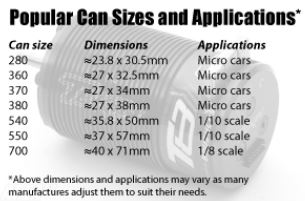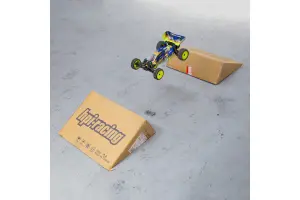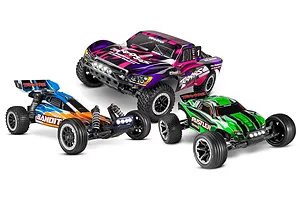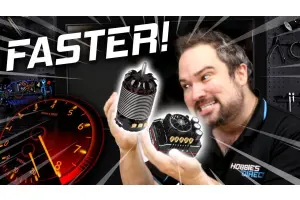Radio Control Hobby Abbreviations/Glossary - Updated 2023
Angus McRitchie
|
2nd May, 2016
|
27 min read
Radio Control Hobby Abbreviations/Glossary
It can be easy to get a bit confused being a beginner trying to get into the exciting hobby of radio control which basically has its own language. Let me try and help to clear a few things up with this list of abbreviations. Please note, there are a lot more abbreviations out there and this is just a list of the most common ones. If you feel like I’ve missed some important ones please comment below with your suggestions.
Common/Miscellaneous
- RC - Radio Control, you may see ‘remote control’ but ‘radio control’ is technically correct. Remote control is any vehicle controlled remotely – even tether line planes and slot cars. Radio control is a type of remote control, so for accuracy’s sake, RC is most correctly Radio Control.
- RTR - Ready To Run, a term used in RC vehicles meaning that it’s pre-assembled and “Ready To Run”, although most of the time you’ll need to buy a battery and charger.
- ARR – Almost Ready to Run, a term used in RC vehicles meaning that it’s pre-assembled and “Almost Ready to Run”, normally this means that the model does not include a battery, motor and radio gear (transmitter and receiver).
- Kit - A term used in RC vehicles meaning that it’s a ‘build yourself’ kit and also generally it doesn’t come with electronics.
- BND – Bind N Drive - a term used in RC vehicles meaning that only a transmitter is needed to use the vehicle.
- SCT – Short Course Truck, the real sized equivalent vehicles are generally referred as “stadium trucks” and “trophy trucks”.
- ST – Stadium Truck, not to be confused with the shape of a full-scale stadium truck. These are often 2WD and fit somewhere between a truggy and a truck.
- MT – Monster Truck, generally a truck has long suspension travel, large wheels, and high ground clearance just like their full-scale counterpart.
- Truggy – These vehicles generally have a very wide track width (which is the distance between the centre of the left and right wheels), large wide wheels and a low ground clearance making them very stable and easy to drive. The name truggy comes from having a combination of design features from both trucks and buggies.
- Rock Crawler – This is a type of vehicle that specialises in overcoming harsh and difficult terrain. Remote control rock crawlers generally allow for a large amount of articulation (the rear wheels could be horizontal when the front wheels are at a 45-degree angle) and are normally limited in speed, in favour of massive amounts of torque which makes them perfectly suited to rock crawling. Some rock crawlers even have the option to allow all 4 wheels to steer.
- Blitzer Beetle - The greatest RC car ever made; also much-loved star of YouTube Horror Movies.
- Scale – eg. 1/5, 1/8, 1/10, 1/16 etc. 1/5 scale is larger than 1/10. 1/10 scale indicates the model is 1/10th the size of its life size equivalent. For example, if you lay ten 1/10th scale RC on-road cars end to end they will equal the length of a real car, the same applies for width and height.
- RPM – Revolutions per minute.
- CA – Cyanoacrylate. This is a type of fast drying superglue, usually used on tyres and to repair foam aircraft.
- WOT - Wide Open Throttle – What you do on a racetrack seconds before being overtaken by Ron.
- FPV - First Person View
- CG or COG - Center of gravity.
- LCG – Low centre of gravity.
- Tire Sauce - a mixture of chemicals or other additive used on tires to improve grip.
- LWB – Long Wheelbase; longer than a short wheelbase.
- SWB – Short Wheelbase; shorter than a long wheelbase.
- ROLLER – A rolling chassis, needing electronics for completion.
- SLIDER – Like a Roller, but needing wheels as well.
- 4WD – 4 Wheel Drive. All 4 wheels of the car have drive. Similar to all-wheel-drive and 4x4, crawlers have drive to all four wheels, but they are locked together and always turn at the same speed.
- AWD – All wheel drive. Used interchangeably with 4WD.
- 2WD – 2 Wheel Drive. Only 2 wheels of the vehicle have drive; in the RC world, it is usually the rear.
- RWD - Rear Wheel Drive. Used interchangeably with 2WD.
- FWD – Front wheel drive.
- 4x4 – or 4-by-4. Used interchangeably with 4WD and AWD.
- Spool - A full spool replaces the entire factory differential case with a solid unit and locks both axles together. A similar effect can be achieved with a diff-locker, or extremely thick differential oil.
- IFS - Independent Front Suspension allows each side of the vehicle to move independently from the other side.
- MOA – Motor on Axle. An older design in which the motor of the vehicle is mounted directly to the axle assembly, usually before the shock absorber. An extremely sturdy and reliable design, but one that produces some …interesting handling characteristics.
- cSt – Centistrokes. A unit that measures the thickness (viscosity) of a fluid. In layman's terms, viscosity defines a fluid's resistance to flow. Usually used when measuring silicone shock and diff oil The higher the viscosity of a liquid, the thicker it is and the greater the resistance to flow.
- CPS – centipoise. Another unit of measuring viscosity. Usually used when measuring silicone shock and diff oil. Like cSt, the higher the number, the thicker the fluid.
- WT – Weight. Yet another unit of measuring viscosity. Usually used when measuring silicone shock and diff oil . Like cSt and Cps, the higher the number, the thicker the fluid.
- LHS - Local Hobby Store. If you are anywhere near Geelong, that's us!
- CC - Cubic Centimeters. Used to measure an engine's capacity, e.g. 29cc, 32cc, 45cc.
Radio – Transmitters and Receivers
- 2.4GHz - A specific frequency band. Radio systems that use 2.4GHz have very little interference and have very little chance of glitches and generally, have small antennas compared to the older MHz radio systems.
- CH – Channel, refers to how many “controls” or “signals” the device is capable of eg. Throttle uses 1 channel, steering uses 1 channel; therefore the most basic car requires a 2CH radio system.
- Trim – A small constant offset applied to a control/channel eg. If your car is constantly turning slightly left without any input, you can adjust the steering trim (setting in your transmitter) in the opposite direction in order to straighten the wheels so your car goes straight.
- D/R – Dual Rate is typically adjusted by a dial on your transmitter but sometimes on a switch that can control the amount (more or less) of total movement/travel of your servo on that channel.
- EPA – End Point Adjustments or sometimes referred to as “travel". Similar to D/R, EPA adjusts the total movement/travel of your servo on that channel but, EPA can adjust both directions indentedly. For example, you could adjust your steering servo EPA to the left independently to the right.
- Bind – Binding is a process of “pairing” a transmitter to a receiver. Once the binding process is performed, that receiver will only communicate with the transmitter used unless the binding process is performed again with a different transmitter. Binding does not apply to older technologies like 27MHz where crystals are used.
- ST – Steering.
- TH – Throttle.
- REV – Reverse, Usually refers to the direction of a channel. This is the opposite of NOR (Normal).
- NOR – Normal, Usually refers to the direction of a channel. This is the opposite of REV (Reverse).
- TX – Transmitter.
- RX – Receiver.
- PWR – Power.
- BND – Bind (Refer to Bind).
- TSM – Traxxas Stability Management. Traxxas stability management uses sophisticated sensors and software to make small adjustments to the car's steering. For example, when you power through a turn, the TSM will sense when the car starts to fishtail, and the system will automatically adjust steering. The minor steering adjustments help keep the car under control and driving forward as fast as possible, and make you look and feel like a better driver than you are.
- AVC – Active Vehicle Control. Available in Horizon Hobby vehicles that come with Spektrum Electronics, AVC is similar to Traxxas TSM, but with the ability to modulate throttle if needed. Can behave like traction control in a real car. Also uniquely frustrating to calibrate.
- SVC – Smart Vehicle Control, by FlySky. Same as both of the above, but can work with the ABS brake function to aid in braking as well as traction and stability.
- SAFE - Sensor Assisted Flight Envelope. Created by Spektrum, this is specifically programmed for the airframe it is installed in and will help keep the aircraft level in flight in even the windiest of conditions. It uses sensors through the control surfaces of the aircraft and combats against the sudden movements from turbulence resulting in a smoother flight. The fact that it spells the word "safe" is totally a coincidence.
- BNF – Bind N' Fly airplanes/quads/helis already come with a receiver so all that is required is for you to bind the receiver to your radio. It is important to make sure that the receiver that comes with the model is compatible with your radio. For instance, if you have a Spektrum transmitter, only aircraft with Spektrum receivers will be able to bind to it. Most radios and receivers are proprietary and only work together.
- ARF - Almost Ready to Fly. Some included components such as servos and motors do not come pre-installed and will need to be installed during the build process. Also, the sound a dog makes.
- PNP - Plug N' Play simply means that your own transmitter, receiver and battery is required to fly. PNP planes already come with motor, ESC, servos (and often LED lights, flaps and more) all pre-installed.
- RTF – Like Ready to Run, but Ready to Fly.
- Expo - Exponential. Refers to an exponential signal increase (as opposed to a linear increase), effectively making the control movement disproportional to your inputs. This is a way to "soften" the control sensitivity around center. This helps the RC vehicle be less twitchy and easy to drive, if not the most reactive. You still have the full range of control, however initial input is softened to decrease sensitivity.
- Mode 1 - Refers to the set-up of the transmitter where the left stick operates the elevator and rudder, and the right stick operates the throttle and ailerons. This is a less-common mode for transmitter layout. See Mode 2 for the typical setup.
- Mode 2 - Mode 2 refers to the set-up of the transmitter where the left stick operates the throttle and rudder, and the right stick operates the elevator and ailerons. This is the most common transmitter mode.
- Mode 3 - Left stick operates elevator & ailerons, right stick operates throttle & rudder.
- Mode 4 - Left stick operates throttle & ailerons, right stick operates elevator & rudder.
- PWM - Pulse Width Modulation - Also referred as Frequency. Basically determines the overall smoothness or aggression of throttle delivery.
- THR - Throttle Rate - similar adjustment to above.
Electrical
- AC/DC - Not just a great band, but also stands for Alternating Current and Direct Current. You’ll see this one a lot with regards to RC chargers and accessories. Basically, Alternating Current (AC) is when you can plug into a wall like a kettle, DC (Direct Current) is when you plug into another battery (like the one in your real car) with alligator clips.
- Alligator Clips – Like Crocodile clips, but these will see you later.
- Brushless – Design/technology of an electric motor where brushes are not used – very common in high powered radio control models and in other high powered products like power tools.
- Brushed – Design/technology of electric motor where brushes are used to deliver power to the commutator. Very common in toys and beginner radio control models as they are cheap to make and require simple electronics.
- ESC - Electronic Speed Control is the unit that delivers the appropriate amount of power to your motor, depending on the signal from your receiver/transmitter. Most ESCs also have a BEC (battery eliminator circuit) which converts the input voltage (battery voltage) and outputs it through the receiver as ~5-6 volts which from there gets distributed to your servos as well.
- LiPo - Lithium Polymer or more correctly Lithium Ion Polymer, a type of battery chemistry – very common in high powered RC vehicles, mobile phones, and portable electronic devices. LiPo batteries offer higher energy density than NiMH and NiCd batteries - read more about LiPo and NiMH batteries.
- NiMH - Nickel Metal Hydride, a type of battery chemistry – Commonly included with Ready To Run vehicles as they’re more affordable.
- NiCd - Nickel Cadmium, a type of battery chemistry – similar to NiMH batteries but suffer from the “memory effect”. Not very common in the hobby of radio control anymore.
- V – Voltage is often referred to as electrical potential. This is one of many things that control how fast your RC car can go. In general, the higher the voltage, the faster the motor will go but also, the hotter the motor will get.
- A – Ampere often shortened to ‘amp’. A measurement of electrical current used in conjunction with volts to calculate power (watts). This is not to be confused with Ampere-hours (Ah). In context with RC’s, chargers that have higher amp output will take less time to fully charge a battery.
- mA – Milliampere – a milliampere (mA) is 1000th of an ampere (A). Refer to ampere for further detail.
- Ah – Ampere-hour often shortened to ‘amp-hour’. This is a measurement of amperage over 1 hour. To put in the context of a battery, this is how much capacity your battery can hold. Simply put, the higher the number, the longer your car will run for on a single charge but if charged at the same rate will take longer to charge. A higher ampere-hour battery generally results in a larger or heavier battery when compared to a lower ampere-hour battery of the same type.
- mAh – Milliampere-hour – A milliampere-hour (mAh) is 1000th of an ampere-hour ( Ah ). This is the most common unit for measuring an RC battery. Refer to Ampere hour for further detail.
- C – Capacity, when displayed on a battery, the C rating indicates how quickly a battery can be charged or discharged without causing permanent damage to the battery. Some companies will only display a discharge C rating, in these cases, charging is expected to be performed at the industry standard – currently 1C for LiPo, NiMH and NiCd batteries. Higher quality batteries generally allow for higher C ratings.
- S - Series, this letter when displayed on a battery (which is always preceded by a number) indicates how many cells are wired in a series configuration. When batteries are wired in series the total battery voltage is equal to the number of cells wired in this configuration times the cell voltage. For example, Lithium Polymer batteries have a cell voltage of 3.7v and when wired in a 2S configuration you get a total battery voltage of 2(2S) x 3.7v (cell voltage) = 7.4v (total battery voltage). People commonly use these abbreviations as it is a lot easier to say “six s” than it is to say “twenty-two point two volts” which in this scenario refers to the voltages of Lithium Polymer batteries.
- BEC – Battery Eliminator Circuit, generally used in ESCs to allow higher voltages from the battery to power the receiver and servos.
- Servo – This is an electronic device that converts an electronic signal into physical motion. All remote control cars implement servo/s to provide steering control.
- KV – a term used to indicate how many thousand revolutions per minute (K) an electric motor will complete per volt (V) without a load in a perfect world (the real world figures will always be lower than the rated KV due to many real world factors such as drag, heat, load etc). KV is used with most sensorless brushless motors, and sensored brushless and brushed motors use Turns.
- Turns – How many times the wire is wrapped around the armature inside an electrical motor. Generally speaking, more turns = higher torque & lower top RPM and fewer turns = lower torque & higher top RPM.
- EDF - Electric duct fans (EDF) operate with less noise and more efficiency while still offering RC aeromodellers the potential to experience the thrill of seeing their winged replicas soar through the air. Think of them as jet engines, just electric.
- LVC – Low Voltage Cutoff. LVC is programming within your vehicle’s ESC which senses battery voltage and cuts power to your motor before you drain the battery too far and harm it. A fully charged Lipo cell is around 4.2v (nominal is 3.7v), and typically LVC is set at about 3.2v-3.6v per cell.
- Wh – Watt-Hours. Calculating the watt-hours based on the information printed on the outside of a battery is not difficult. Multiply the given volts by the battery capacity, shown as milliamps or mAh. Divide the sum by 1,000 to get the watt-hour rating.
- HV or LiHV – High Voltage. These lithium cells can be charger to a higher maximum voltage (~4.35v.cell) and have a slightly higher nominal voltage (~3.8v/cell). Sizes are 7.6v 2S, 11.4v 3S, 15.2v 4S, 22.8v 6S.
- Continuous / Burst Current – Continuous current measures how much current an ESC can handle continuously, for an extended period of time. Burst current measures how much current an ESC can handle for a short amount of time, such as the first few seconds of hard acceleration.
- Shorty – A “Shorty” LiPo pack is shorter than a standard pack (95mm vs. 140mm), hence the name.
- Parallel – When 2 identical batteries are connected in Parallel, the Voltage remains the same, but available Capacity doubles. The C rating stays the same, but as the capacity has doubled, so has the C value. This is only a minor detail though, as functionally this is the same available current as if the C rating doubled but capacity stayed the same. Headache.
- Series - When 2 identical batteries are connected in Series, the Capacity remains the same, but Voltage doubles. The C rating and value remains the same.
- LED –Light Emitting Diode.
- AWG - AWG or American Wire Gauge is the US (and Australian) standard measure for the diameter of electrical conductors. The American Wire Gauge chart is based on the number of dies originally required to draw the copper down to the required dimensional size. It means the higher the AWG number is, the smaller the wire diameter is. This must make more sense if you're American. AWG12 - small and good for lower current draw applications (awesome old Tamiya cars), AWG8 - larger and good for high current draw setups (Arrma, X-Maxx).
- IPX4 – “IP” is a water-resistance rating. IPX4 Is resistant to water splashes from any direction. It is not submersible.
Brushless Motor Sizes – 3652 – This motor has a diameter of 36mm, and is 52mm in length. - Brushed Motor Sizes – There really doesn’t seem to be any rhyme or reason to how this is worked out, so here’s a chart.
- CC/CCW - Clockwise/Counter-Clockwise. Usually referring to motor direction and seen during ESC programming.
Related Posts
Comments




